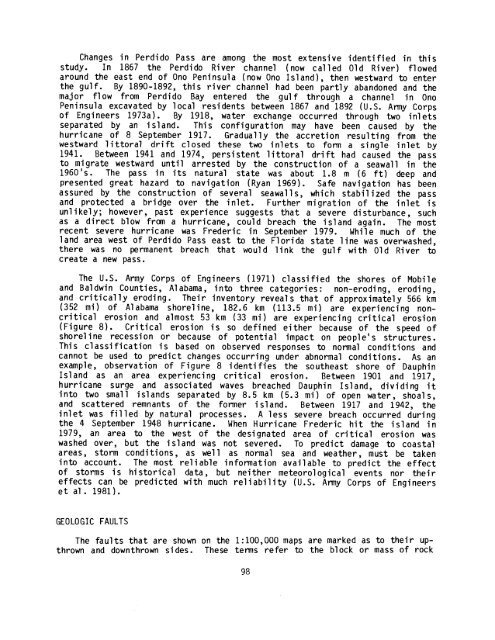ecological characterization atlas of coastal alabama - Data Center
ecological characterization atlas of coastal alabama - Data Center
ecological characterization atlas of coastal alabama - Data Center
You also want an ePaper? Increase the reach of your titles
YUMPU automatically turns print PDFs into web optimized ePapers that Google loves.
Changes in Perdido Pass are among the most extensive identified in this<br />
study . In 1867 the Perdido River channel (now called Old River) flowed<br />
around the east end <strong>of</strong> Ono Peninsula (now Ono Island), then westward to enter<br />
the gulf . By 1890-1892, this river channel had been partly abandoned and the<br />
major flow from Perdido Bay entered the gulf through a channel in Ono<br />
Peninsula excavated by local residents between 1867 and 1892 (U .S. Army Corps<br />
<strong>of</strong> Engineers 1973a) . By 1918, water exchange occurred through two inlets<br />
separated by an island . This configuration may have been caused by the<br />
hurricane <strong>of</strong> 8 September 1917 . Gradually the accretion resulting from the<br />
westward littoral drift closed these two inlets to form a single inlet by<br />
1941 . Between 1941 and 1974, persistent littoral drift had caused the pass<br />
to migrate westward until arrested by the construction <strong>of</strong> a seawall in the<br />
1960's . The pass in its natural state was about 1 .8 m (6 ft) deep and<br />
presented great hazard to navigation (Ryan 1969) . Safe navigation has been<br />
assured by the construction <strong>of</strong> several seawalls, which stabilized the pass<br />
and protected a bridge over the inlet . Further migration <strong>of</strong> the inlet is<br />
unlikely ; however, past experience suggests that a severe disturbance, such<br />
as a direct blow from a hurricane, could breach the island again . The most<br />
recent severe hurricane was Frederic in September 1979 . While much <strong>of</strong> the<br />
land area west <strong>of</strong> Perdido Pass east to the Florida state line was overwashed,<br />
there was no permanent breach that would link the gulf with Old River to<br />
create a new pass .<br />
The U .S . Army Corps <strong>of</strong> Engineers (1971) classified the shores <strong>of</strong> Mobile<br />
and Baldwin Counties, Alabama, into three categories : non-eroding, eroding,<br />
and critically eroding . Their inventory reveals that <strong>of</strong> approximately 566 km<br />
(352 mi) <strong>of</strong> Alabama shoreline, 182 .6 km (113 .5 mi) are experiencing noncritical<br />
erosion and almost 53 km (33 mi) are experiencing critical erosion<br />
(Figure 8) . Critical erosion is so defined either because <strong>of</strong> the speed <strong>of</strong><br />
shoreline recession or because <strong>of</strong> potential impact on people's structures .<br />
This classification is based on observed responses to normal conditions and<br />
cannot be used to predict changes occurring under abnormal conditions . As an<br />
example, observation <strong>of</strong> Figure 8 identifies the southeast shore <strong>of</strong> Dauphin<br />
Island as an area experiencing critical erosion . Between 1901 and 1917,<br />
hurricane surge and associated waves breached Dauphin Island, dividing it<br />
i nto two smal l i sl ands separated by 8 .5 km (5 .3 mi ) <strong>of</strong> open water, shoal s,<br />
and scattered remnants <strong>of</strong> the former island . Between 1917 and 1942, the<br />
inlet was filled by natural processes . A less severe breach occurred during<br />
the 4 September 1948 hurricane . When Hurricane Frederic hit the island in<br />
1979, an area to the west <strong>of</strong> the designated area <strong>of</strong> critical erosion was<br />
washed over, but the island was not severed . To predict damage to <strong>coastal</strong><br />
areas, storm conditions, as well as normal sea and weather, must be taken<br />
into account . The most reliable information available to predict the effect<br />
<strong>of</strong> storms is historical data, but neither meteorological events nor their<br />
effects can be predicted with much reliability (U .S. Army Corps <strong>of</strong> Engineers<br />
et al . 1981) .<br />
GEOLOGIC FAULTS<br />
The faults that are sho wn on the 1 :100,000 maps are marked as to their upthrown<br />
and downthrown sides . These terms refer to the block or mass <strong>of</strong> rock<br />
98
















